MUSIC PAPER 1 GRADE 12 MEMORANDUM - NSC EXAMS PAST PAPERS AND MEMOS NOVEMBER 2018
Share via Whatsapp Join our WhatsApp Group Join our Telegram GroupMUSIC
PAPER 1
GRADE 12
NSC EXAMS
PAST PAPERS AND MEMOS NOVEMBER 2018
MEMORANDUM
SECTION A: THEORY OF MUSIC (COMPULSORY) (90 minutes)
Answer QUESTION 1
AND QUESTION 2.1 OR 2.2
AND QUESTION 3.1 OR 3.2
AND QUESTION 4.1 OR 4.2.
QUESTION 1 (25 minutes)
Study the extract and answer the questions that follow.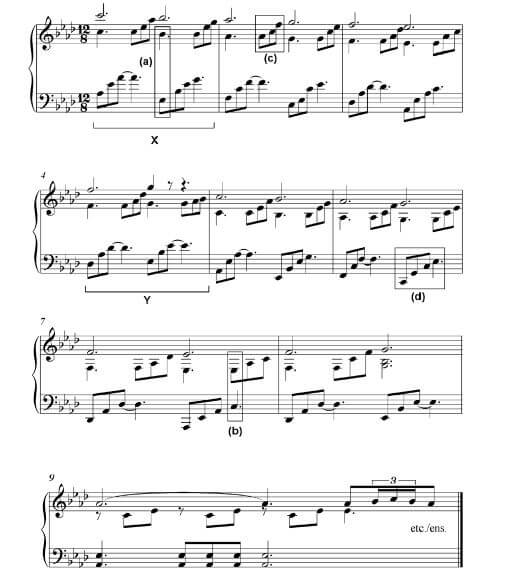
1.1 Name the submediant minor key of this piece.
- Answer: F (minor) (1)
1.2 Name the related dominant major key of this piece:
- Answer: Eb(major) (1)
1.3 Name the intervals at (a) and (b) according to type and distance. Answer:
- Compound Perfect 5th/Perfect 12th
- Minor 3rd (2)
1.4 Transpose the bass part of bar 1 at X a perfect 5th lower. Insert the new key signature.
Answer:  (3)
(3)
Correct key signature = 1 mark |
1.5 Describe the triads at (c) and (d) according to type and position.
Answer:
(c) Minor, First inversion
(d) Minor, Root position(2)
2x½ = 1 mark |
1.6 Halve the note values and rewrite the bass clef part at Y in bar 4. Insert the new time signature.
Answer: 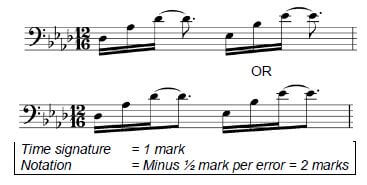 (3)
(3)
Time signature = 1 mark |
1.7 Complete the melody below by writing ascending sequences as indicated.
Answer: 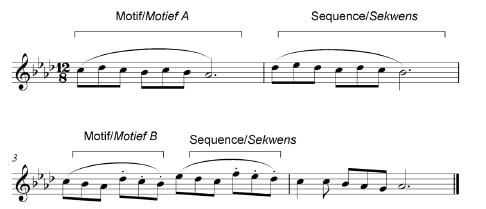 (4)
(4)
Motif A = 2 marks |
1.8 Select the scale/mode on which each of the following TWO extracts is based. Make a cross (X) in the appropriate block.
1.8.1 Answer: Dorian mode (1)
1.8.2 Answer: Whole-tone scale (1)
1.9 Write F# melodic minor scale ascending and descending without key signature in the given clef. Use only semibreves and indicate the semitones.
Answer: ![]() (2) [20]
(2) [20]
Ascending = 1 mark |
QUESTION 2 (25 minutes)
Answer EITHER QUESTION 2.1 OR QUESTION 2.2.
2.1 Complete the opening below to form a twelve-bar melody in ternary form for any single-line melodic instrument of your choice. Name the instrument and supply a suitable tempo indication. Add dynamic and articulation indications where applicable.
Concept answer: Instrument: Saxophone/Clarinet/Trumpet/Violin/Flute/Oboe/Horn, etc. Allegretto 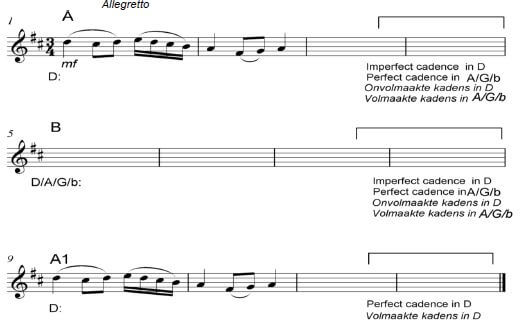
OR
2.2 Complete the opening below to form a twelve-bar melody in ternary form for any single-line melodic instrument of your choice. Name the instrument and supply a suitable tempo indication. Add dynamic and articulation indications where applicable.
Concept answer: Instrument: Saxophone/Clarinet/Trumpet/Violin/Flute/Oboe/Horn, etc. 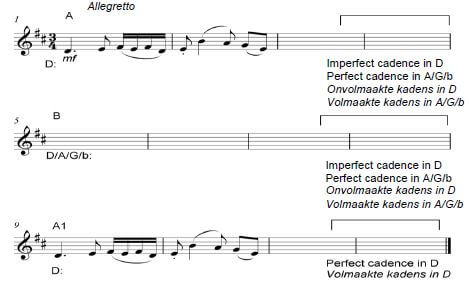
The melody will be marked according to the following criteria: [15]
DESCRIPTION | MARK ALLOCATION | ||
Form and cadential points | 1 mark per phrase x 3 | 3 | |
Correctness | Minus ½ mark per error up to 2 marks | 2 | |
Quality
| 9–10 | Excellent | 10 |
7–8 | Good | ||
4–6 | Average | ||
0–3 | Not acceptable | ||
TOTAL | Markers may use ½ marks | 15 | |
QUESTION 3 (10 minutes) Answer EITHER QUESTION 3.1 OR QUESTION 3.2.
3.1 Study the extract and answer the questions.
Answer: 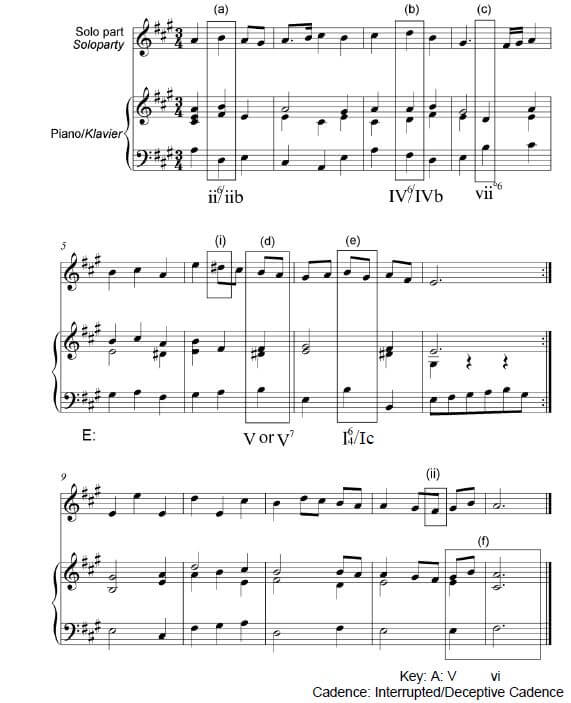
3.1.1 Name the new key to which the piece modulates in bars 5–8. Write the answer on the score.
- Answer: See score (1)
3.1.2 Figure the chords at (a)–(e) with Roman numerals on the score, e.g. iii6/iiib
- Answer: See score (5)
1 mark per chord = 5 marks |
3.1.3 Identify the cadence at (f) in bars 12–13 on the score. Indicate the key and figure the chords with Roman numerals.
- Answer: See score (2)
½ mark for key | = 2 marks |
3.1.4 Name the type of non-chordal notes at (i) and (ii).
- Answer (i) Passing note
(ii) Auxiliary note/Neighbouring note(2) [10]
OR
3.2 Study the extract and answer the questions.
Answer: 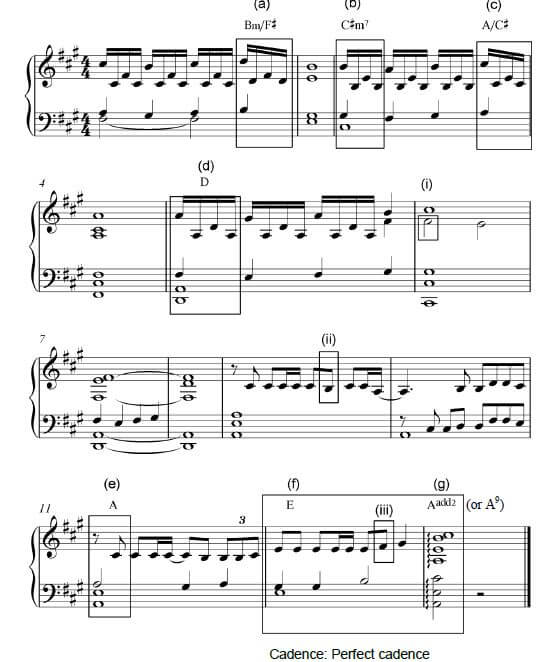
3.2.1 Identify the chords (a)–(e) and write chord symbols in the spaces provided on the score, e.g. Bb/D.
- Answer: See score (5)
1 mark per chord = 5 marks |
3.2.2 Name the types of non-chordal notes at (i)–(iii).
- Answer: (i) Suspension
(ii) Auxiliary/Neighbouring note
(iii) Passing note(3)
3.2.3 Name the cadence which is formed in bars 12–13 on the score. Indicate the chord symbols at (f) and (g).
- Answer: Perfect cadence, E – Aadd2 (or A9) (2) [10]
Cadence = 1 mark | = 2 marks |
QUESTION 4 (30 minutes)
Answer EITHER QUESTION 4.1 OR QUESTION 4.2.
4.1 Complete the four-part vocal harmonisation below by adding the alto, tenor and bass parts.
Concept answer: 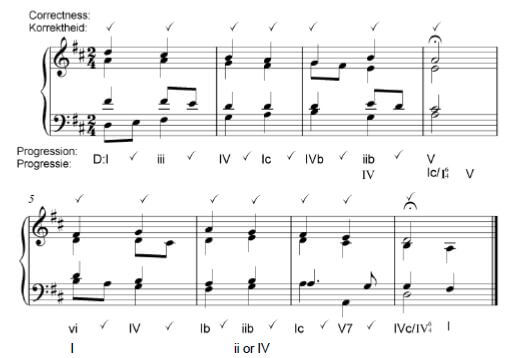
The harmonisation will be marked according to the following criteria:
DESCRIPTION | MARK ALLOCATION | |
Chord progression | 1 mark between each pair of chords (except between bars 4, 5 and 8) | 12 |
Correctness | Minus ½ mark per error but not more than 1 mark per chord | 14 |
Quality | Excellent = 3½–4 marks | 4 |
Note to marker: | 30 (÷ 2) | |
TOTAL | 15 | |
Candidates must be credited for a different/creative and correct harmonisation not given in the marking guidelines. The figuring serves as a guide for the marker, but no marks are allocated for the symbols as such.
OR
4.2 Complete the piece below by adding suitable harmonic material in the open spaces on the stave. Continue in the style suggested by the given material in bars 1 and 2.
Concept answer: 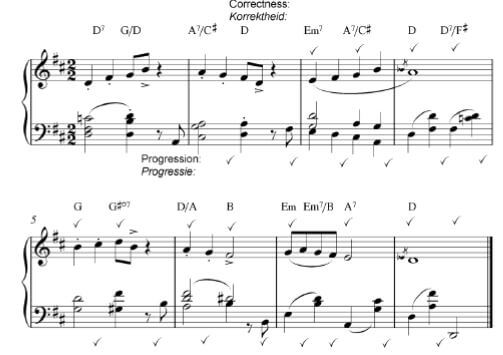
The answer will be marked according to the following criteria:
DESCRIPTION | MARK ALLOCATION | |
Chord progression | 1 mark between each pair of chords | 14 |
Correctness | Minus ½ mark per error but not more than 1 mark per chord | 12 |
Quality | Excellent = 3½–4 marks | 4 |
Note to marker: | 30 (÷ 2) | |
TOTAL | 15 | |
Candidates must be credited for a different/creative and correct harmonisation not given in these marking guidelines. The figuring serves as a guide for the marker, but no marks are allocated for the chord symbols as such.
TOTAL SECTION A: 60
SECTIONS B, C, D, E: GENERAL MUSIC KNOWLEDGE (90 minutes)
Answer SECTION B
AND SECTION C (Western Art Music)
OR SECTION D (Jazz)
OR SECTION E (Indigenous African Music).
Note to marker: One mark will be allocated for each correct fact. Candidates must be credited for any correct answer not given in these marking guidelines. Regardless of the fact that this marking guideline is constructed in bullet form, it is expected that the candidate answers the questions in paragraph/essay form where required. |
SECTION B: GENERAL (COMPULSORY)
QUESTION 5
5.1
5.1.1 B
5.1.2 C
5.1.3 D
5.1.4 B
5.1.5 D
5.1.6 D
5.1.7 D
5.1.8 B
5.1.9 C
5.1.10 B (10)
5.2
5.2.1 B
5.2.2 A
5.2.3 E
5.2.4 C
5.2.5 D (5)
FIVE correct answers = 5 marks |
5.3 ∙ Song writer/composer
- Performer/singer/band member/session musician
- Sound engineer
- Editor/director
- Recording engineer
- Producer/recording company
- Arranger
- Lyricist (5)
Any FIVE correct answers = 5 marks |
[20]
TOTAL SECTION B: 20
Answer SECTION C (WAM)
OR SECTION D (JAZZ)
OR SECTION E (IAM).
SECTION C: WESTERN ART MUSIC (WAM) QUESTION 6
6.1
- Clarinet
- French Horn
- Trumpet (2)
TWO correct answers = 2 marks |
6.2 Clarinet (1)
6.3
- Two
- Timpani/Kettle drums(1)
6.4 (3)
Codetta | Coda | |
Where in the work | Found at the end of the exposition | Found at the end of the recapitulation |
Key | Ends in a related key | Ends in the tonic key |
Function | Tail section as ending and rounding off the exposition | Tail section to end off the movement |
Length | Usually a short section | Sometimes short, but often an extensive section |
Structural function | Usually in the form of a repeated (extended) cadence (in new key) | New material introduced or previously stated material may be developed with extended cadence at the end |
Any THREE correct correlated differences = 3 marks Candidates may answer in table format |
6.5
6.5.1  [10]
[10]
QUESTION 7
7.1 In Diesen Heil'gen Hallen/Within these Hallowed Halls (1)
7.2
- Sung by Sarastro – a symbol of good
- Bass voice – reinforces stable attitude
- Act 2 – contrasts with the Queen of the Night's vengeful second aria
- Fairly slow tempo: Larghetto – to reinforce 'holiness' of the temple
- Key: E major – to establish a positive, reassuring atmosphere
- Form: 2 verses – simplicity of form reinforces calm, stable mood
- Use of melismas
- Mood: serious, calm and reassuring
- Sarastro sings of love, duty and forgiveness / ideals of brotherhood
- Instrumentation: 2 flutes, 2 bassoons, 2 horns, string section
FOUR correct facts = 4 marks |
QUESTION 8
- Established the layout of the standard Classical orchestra
- Arrangement of the standard Classical orchestra into 4 instrument groups
- Each section of orchestra given a particular role
- Large string section with violins playing the principle melody
- Doubled instruments in woodwinds (excluding clarinet) as a binding/filling role
- Woodwinds as melodic instruments
- Restricted use of brass and percussion (two timpani) for the ff sections
- Basso continuo was omitted
- The bass part is given a stronger forward rhythmic drive
- French Horns act as a harmonic binding agent
- Introduced the four movement symphony
- Performance techniques developed
- Tremolo
- Sudden sfz
- Opening arpeggios
- Crescendos and decrescendos
- Playing techniques: The rocket- and sigh-motives [5]
Any FIVE correct facts |
QUESTION 9
Instrumentation
- Increases number of instruments in orchestra
- Use of timpani more for dramatic effect than for harmonic reinforcement
- Piccolo adds colour to the exhilaration and tension
- Trombones added for intensity and power of sound colour and range Dynamics
- Greater range and extremes of dynamics are used than before (pp – ff)
- ff in tremolos of string passages
- pp string passage at end of the symphony
- Sudden changes in dynamics for dramatic purposes e.g. fortepiano fp
- More use of accents (sf) and climaxes
- Extensive use of crescendi and decrescendi in successive 'waves'
- Extended orchestration to increase dynamic possibilities [5]
Any FIVE facts as long as both dynamics and instrumentation are included = 5 marks |
QUESTION 10
Answer:
Origin
- Composed as a result of a visit to Scotland – the Hebrides islands
- Inspired by a cavern known as Fingal's Cave and the surrounding seascape, even made sketches of the island
- A boat ride to these islands had a huge impact on him
- He wrote letters to his sister describing this emotional experience
- Completed in 1830 (The Lonely Island), revised and renamed in 1833
Any THREE correct facts = 3 marks |
Description of composition
Form
- Concert overture
- An independent single movement work
- Sonata form OR Allegro-Sonata form
- Exposition: B minor - D Major
- Development: D Major
- Recapitulation: starts in B minor; includes new material in bridge; 2nd subject in B Major; extended Coda
- The bridge passages are greatly extended
Only 1 mark for keys |
Instrumentation/Orchestration
- A work for standard Classical orchestra
- Innovative orchestration resulted in new combinations of colour and mood e.g. use of upper pedal points
- No additional instruments as was the case in most other Romantic orchestral works
- Both themes are played by the lower register instruments (cello, bassoon, viola)
- Demands greater technical competence from the orchestral players
- Instrumentation/orchestration contribute to the mood
- the murmur of the sea depicted by the tremolo in the strings
- the crashing waves depicted by sforzandi chords for the orchestra tutti
- the sea swells depicted by the movement of the opening theme played by cello, viola and bassoon
Any THREE correct facts = 3 marks |
Style
- Use of chromaticism
- Extreme dynamic contrasts
- A dramatic symphonic work with programmatic content
- Texture: Mostly homophonic
- Tempo: Allegro moderato
- Tempo fluctuations - rubato
- Programmatic nature and sets a scene but does not tell a story
Any THREE correct facts = 3 marks |
Logical presentation and structure of the essay = 3 marks |
The essay will be marked according to the following criteria:
CRITERIA | MARK ALLOCATION | ||
Origins | 3 marks | 3 | |
Form | 3 marks | 3 | |
Instrumentation/ Orchestration | 3 marks | 3 | |
Style | 3 marks | 3 | |
Logical presentation and structure of the essay | Excellent | = 3 marks | 3 |
Good | = 2–2½ marks | ||
Average | = 1½ marks | ||
Below average | = 1 mark | ||
Weak | = ½ mark | ||
Not acceptable | = 0 marks | ||
TOTAL | 15 | ||
[15]
TOTAL SECTION C: 40
SECTION D: JAZZ
QUESTION 11
11.1
- Trumpet
- Saxophone
11.2
- Keyboard/organ
- Guitar
- Bass guitar
- Drum kit
Any TWO correct answers = 2 marks |
11.3 (4)
POPULAR SONG FORM | BLUES FORM |
32 bars | 12 bars (with lyrics in AAB form) |
AABA form/Verse and chorus | One part form |
Diatonic chord progression e.g. A: I-vi-IV-V B: V7/vi - V7/ii - V7/V - V7 | I7, IV7 and V7in a 12-bar cyclic scheme (All chords have a minor seventh added) F7(4 bars), Bb7(2 bars), F7(2 bars), C7(1 bar), Bb7(1 bar), F7(2 bars) |
Two contrasting themes | One theme |
Any TWO correct correlated differences 2 x 2 = 4 marks Candidates may answer in table format |
11.4
11.4.1 Improvisation/Jamming (1)
11.4.2
- Comping
- Improvisational chordal accompaniment (1)
Correct fact = 1 mark |
11.4.3 Substitution (1) [10]
QUESTION 12
Answer:
Characteristics
- A unique fusion of African jazz with rhythms and melodies of traditional vhaVenda and baPedi music
- Melodies, percussion and language derived from baPedi and vhaVenda cultures ∙ Prominent use of African polyrhythms
- African rhythms supplied by the bongo, malombo and meropa
- Lyrical, lilting guitar and flute melodies are extensively used
- Free jazz, blues and rock influences from North America
- Guitar arrangements and improvisatory style are borrowed from musicians such as Wes Montgomery and John McLaughlin
- 12-bar blues structure employed in some compositions
Any FOUR characteristics = 4 marks |
Artist/Band
- Philip Tabane
- Julian Bahula
- Malombo Men
- Malombo Jazz [5]
Any ONE artist/band = 1 mark |
QUESTION 13
Answer:
Marabi
- Both vocal and instrumental music
- Primarily a keyboard style
- Influenced by Duke Ellington (Afro-American fusion)
- Other instruments: piano, pedal organ, guitar/banjo, bass guitar, percussion and voice in a small instrumental ensemble
- Voice and piano have melodic role
- Songs often start with a brief introduction featuring the guitar or piano OR
Kwela
- Instrumental music mostly
- Guitar and banjo outline the chord progression and give rhythmic drive
- The guitar plays the skiffle-like rhythm
- Penny-whistle often used as lead instrument (saxophone added later)
- Songs usually start with a pennywhistle introduction
- Penny-whistle used as a warning signal during apartheid-era [5]
Any FIVE facts = 5 marks |
QUESTION 14
Abdullah Ibrahim
Melody
- Folk-like melodies
- Hymn-like/Chorale style
- Ghoema/Cape Malay characteristics
- Modal melodies
- Extensive improvisational style
- Melodies are often realised on the piano
Any FOUR correct facts = 4 marks |
Relevant example
- Mannenberg, Soweto is where it's at, Tsakwe (Royal Blue) [5]
Any correct example = 1 mark |
OR
Robbie Jansen
Melody
- Folk-like melodies
- Khoisan/Cape Malay melodies interwoven with Malaysian/Indonesian melismatic styles
- Saxophone melody produced with a nasal tone with vibrato at the end of phrases
- Lead-saxophone (alto) mostly plays the melody
- Extensive improvisation for all instruments, blending various styles (eclectic)
Any FOUR correct facts = 4 marks |
Relevant example
- Hoija Tjie Bonga, Tsakwe, Sommer Ghoema [5]
Any correct example = 1 mark |
OR
Winston Mankunku Ngozi
Melody
- Lead-saxophone (tenor) plays the melody
- Folk-like melodies
- Khoi-Khoi and San melodies intertwined
- Malaysian and Indonesian melismatic styles are fused
- Extensive improvisation for all instruments, blending various styles
- Call and response between lead saxophone and other instruments
Any FOUR correct facts = 4 marks |
Relevant example
- Abantwana be Afrika, Crossroads [5]
Any correct example = 1 mark |
QUESTION 15
Reasons for popularity:
- The very popular traditional Zulu Indlamu dance rhythms are prominently part of mbaqanga and that is the reason that it is popular. The modern style mbaqanga is based on the traditional music
- The music style mbaqanga is associated with the popular staple food, 'maize bread'
- A fusion of popular American jazz, mbube, kwela and marabi music caused more people to be drawn to this mixed style
- Introduction of Radio Bantu ensured that many musicians recorded their music for airplay
- The 'spirit of competition' around releasing new recordings made this style popular
- One of the reasons why it became popular is that it was an easy way for musicians to make a quick buck (money)
Any THREE reasons = 3 marks |
Style characteristics
- Use of both traditional and Western instruments
- Fuses traditional and Western music elements
- Electric guitar very important in mbaqanga, e.g. by Mahlathini and the Mahotella Queens
- Electronic organ more important in mbaqanga than in preceding styles of music, e.g. the Soul Brothers
- Sometimes a male-only vocal style: Soul Brothers
- Usually starts with a brief guitar introduction (or in the case of Soul Brothers, the introduction is done by the electronic organ)
- Heavy bass line and rock beat are prominent features
- Chord progression I – IV – V – I cycle over a bouncy 8/8 rhythm
- Music has a repetitive character
- Call and response used between the lead singer/guitarist and the backing singers/band
Any SEVEN style characteristics = 7 marks |
Artist/Band:
- Mahlathini and the Mahotella Queens
- Soul Brothers
- The Cool Crooners
- Makgona Tsohle Band
Any TWO artists/bands = 2 marks |
The essay will be marked according to the following criteria:
CRITERIA | MARK ALLOCATION | ||
Reasons for popularity | 1 mark for each correct fact | 3 | |
Style characteristics | 1 mark for each correct fact | 7 | |
Artists | 1 mark for each correct fact | 2 | |
Logical presentation and structure of the essay | Excellent | = 3 marks | 3 |
Good | = 2-2½ marks | ||
Average | = 1½ marks | ||
Below average | = 1 mark | ||
Weak | = ½ mark | ||
Not acceptable | = 0 marks | ||
TOTAL | 15 | ||
[15]
TOTAL SECTION D: 40
OR
SECTION E: INDIGENOUS AFRICAN MUSIC (IAM)
QUESTION 16
16.1
- vhaVenda drums
- Mbila mutondo
- Mbila dzamedza
- Ngoma
- Tshikona pipes (2)
Any TWO instruments = 2 marks |
16.2 Flute (1)
16.3
- Keyboard/organ
- Guitar
- Bass guitar
- Drum kit (1)
16.4 (3)
Any correct answer = 1 mark |
Indlamu | Mokhibo |
amaZulu dance | baSotho dance |
Fast and energetic | Can be moderate and calm |
Uses mostly the lower body and includes stomping of feet | Uses mostly the upper body and includes the shaking of the back and shoulders |
Performed, using feet | Performed while kneeling |
Any THREE correct correlated differences = 3 marks Candidates may answer in table format |
16.5 16.5.1 Ululation (1)
16.5.2 Izibongo (1)
16.5.3 Chordophone (1) [10]
QUESTION 17
- Traditional elements which were retained are the following:
- Kiba polyrhythms
- Always in Sepedi language
- Call and response between voices and instruments
- Ululation, crepitations and vocal lilting
- Changes which were introduced:
- Modern jazz rhythms are added
- Any modern instruments (guitar, keyboard, drum kit) can be used
- Any African language can be used
- Free kiba is recorded and sold for commercial gain. [5]
Any TWO facts relating to traditional elements = 2 marks Any THREE facts on transformation of elements to modern style = 3 marks | = 5 marks |
QUESTION 18
- He has created a modern version of the malombo style
- He employs various indigenous African languages
- He replaces the original reed flute with a Western flute
- Cyclical chord structures are employed
- Call and response between voice and instrument is used extensively ∙ Vocals, bass guitar, drum kit, indigenous drums and rattles are used [5]
Any FIVE correct facts = 5 marks |
QUESTION 19
- Ancestral worship
- Certain songs and dances exist exclusively to communicate with the ancestors e.g. at funerals and weddings
- Certain songs and dances induce a trance through which contact is established
- Through music and dance the assistance and blessing of the ancestors are sought e.g. during initiation ceremonies
- The participation of the community in the musical activity often signifies the joy of connecting with the ancestral spirits successfully
- Traditional Healers (Sangomas)
- Sangomas are agents and conduits of divinity, e.g. 'Saane' and 'Leepo'
- Sangomas will initiate the process of contacting the ancestral spirits by using invocative singing and praise poetry
- Sangomas will incite the community/people to participate in ceremony
- Singing, drums and whistles are employed during ritualistic performances to provide the link between the worshippers and the divine [5]
Any FIVE correct facts = 5 marks |
QUESTION 20
Playing techniques on guitar
- Ukuvamba technique:
- strumming chords percussively
- Ukupika technique:
- a finger-picking style
- the thumb plays the lower strings ('amadoda', the Zulu word for 'men')
- the other fingers in the right hand (mainly the index finger) plays a melody on the upper strings ('amatombazane', the Zulu word for 'women')
- A plectrum (called ikati) is often used
Any THREE correct facts = 3 marks |
Tuning of the guitar
- Different maskandi use different tunings depending on the specific style of dance/song
- Standard maskanda guitar tuning is called isiZulu-style
- strings are tuned as: EADGBD
- Isishameni-style
- strings are tuned as: DADABD
- Isichunu style
- strings are tuned as: DADABD (as in Isishameni)
- Isigeyane-style
- Uses isiZulu (standard maskanda tuning) but different rhythmic patterns
- Isimandolini style
- strings are tuned as: EBBC#F#G#
Any TWO correct facts = 2 marks |
Style of singing
- Based on amahubo (using the pentatonic scale)
- Umaskanda melody is an authentic remnant of the Zulu amahubo music, the foundation of all Zulu vocal music
- Range of voices is not wide: between a 5th and 11th
- Singers switch between singing and speaking
- Vocal glissandi or pitch bending is used
- Text for umaskanda music is in isiZulu
- Formal design of umaskanda music imitates the vocal style of isiZulu music which in turn is based on Zulu-speech
- Leader (call) and backup singers (response)
Any FIVE correct facts = 5 marks |
Izihlabo
- An instrumental introduction based on a descending motive played on guitar or concertina
- Consists of short bursting motifs
- It sounds like an 'improvised sound check' to check the tuning
- Uses free rhythm and metre
Any TWO correct facts = 2 marks |
The essay will be marked according to the following criteria:
CRITERIA | MARK ALLOCATION | ||
Playing techniques on the guitar | 1 mark for each correct fact | 3 | |
Tuning of guitar | 1 mark for each correct fact | 2 | |
Style of singing | 1 mark for each correct fact | 5 | |
Izihlabo | 1 mark for each correct fact | 2 | |
Logical presentation and structure of the essay | Excellent | = 3 marks | 3 |
Good | = 2-2½ marks | ||
Average | = 1½ marks | ||
Below average | = 1 mark | ||
Weak | = ½ mark | ||
Not acceptable | = 0 marks | ||
TOTAL | 15 | ||
[15]
TOTAL SECTION E: 40
GRAND TOTAL: 120